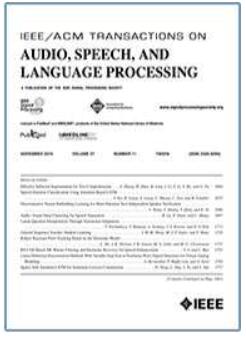Enhancing Conformer-Based Sound Event Detection Using Frequency Dynamic Convolutions and BEATs Audio Embeddings
IF 5.1
2区 计算机科学
Q1 ACOUSTICS
IEEE/ACM Transactions on Audio, Speech, and Language Processing
Pub Date : 2024-08-15
DOI:10.1109/TASLP.2024.3444490
引用次数: 0
Abstract
Over the last few years, most of the tasks employing Deep Learning techniques for audio processing have achieved state-of-the-art results employing Conformer-based systems. However, when it comes to sound event detection (SED), it was scarcely used after it won the DCASE Challenge 2020 Task 4. In previous research, we found that Conformer-based systems achieved a higher performance in terms of sound events classification compared to other architectures frequently employed, such as Convolutional Recurrent Neural Networks (CRNNs). Given that the second scenario proposed for the Polyphonic Sound Detection Score (PSDS2) is focused on avoiding confusion between classes, in this paper we propose to optimize a Conformer-based system to maximize the performance on this scenario. For this purpose, we performed a hyperparameter tuning and incorporated recently proposed Frequency Dynamic Convolutions (FDY) to enhance its classification properties. Additionally, we employed our previously proposed multi-resolution approach not only to enhance the performance but also to gain a deeper understanding of the Conformer architecture for SED, analyzing its advantages and disadvantages, and finding possible solutions to them. Additionally, we explored the integration of embeddings from the pre-trained model BEATs, an iterative framework to learn Bidirectional Encoder representation from Audio Transformers. By concatenating these embeddings into the input of the Conformer blocks, results were further improved, achieving a PSDS2 value of 0.813 and considerably outperforming SED systems based on CRNNs.利用频率动态卷积和 BEATs 音频嵌入增强基于共形器的声音事件检测
在过去几年中,大多数采用深度学习技术进行音频处理的任务都利用基于 Conformer 的系统取得了最先进的成果。然而,当涉及声音事件检测(SED)时,它在赢得 DCASE 挑战赛 2020 任务 4 之后就很少被使用了。在之前的研究中,我们发现基于 Conformer 的系统在声音事件分类方面比其他经常使用的架构(如卷积递归神经网络(CRNN))性能更高。鉴于为复调声音检测评分(PSDS2)提出的第二种方案侧重于避免类别之间的混淆,我们在本文中建议优化基于 Conformer 的系统,以最大限度地提高该方案的性能。为此,我们对超参数进行了调整,并采用了最近提出的频率动态卷积(FDY)来增强其分类性能。此外,我们还采用了之前提出的多分辨率方法,不仅提高了性能,还加深了对 SED 的 Conformer 架构的理解,分析了其优缺点,并找到了可能的解决方案。此外,我们还探索了如何整合来自预训练模型 BEATs 的嵌入,这是一个从音频变换器学习双向编码器表示的迭代框架。通过将这些嵌入信息串联到 Conformer 模块的输入中,结果得到了进一步改善,PSDS2 值达到了 0.813,大大优于基于 CRNN 的 SED 系统。
本文章由计算机程序翻译,如有差异,请以英文原文为准。
求助全文
约1分钟内获得全文
求助全文
来源期刊

IEEE/ACM Transactions on Audio, Speech, and Language Processing
ACOUSTICS-ENGINEERING, ELECTRICAL & ELECTRONIC
CiteScore
11.30
自引率
11.10%
发文量
217
期刊介绍:
The IEEE/ACM Transactions on Audio, Speech, and Language Processing covers audio, speech and language processing and the sciences that support them. In audio processing: transducers, room acoustics, active sound control, human audition, analysis/synthesis/coding of music, and consumer audio. In speech processing: areas such as speech analysis, synthesis, coding, speech and speaker recognition, speech production and perception, and speech enhancement. In language processing: speech and text analysis, understanding, generation, dialog management, translation, summarization, question answering and document indexing and retrieval, as well as general language modeling.
 求助内容:
求助内容: 应助结果提醒方式:
应助结果提醒方式:


